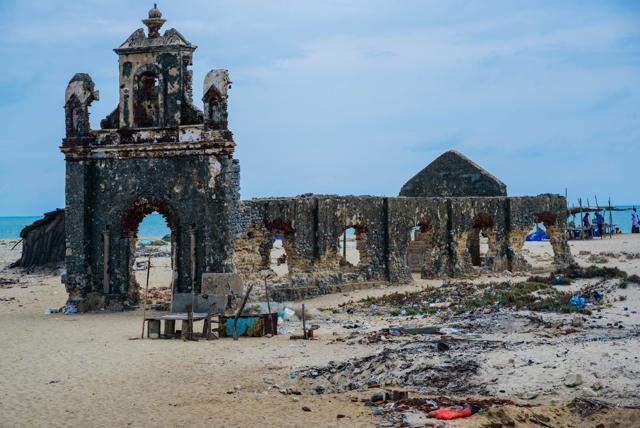Nestled at the southern tip of India, where the Bay of Bengal meets the Indian Ocean, lies a place of haunting beauty and eerie history - Dhanushkodi. This ghost town in Tamil Nadu's Rameswaram district has captivated the imagination of travelers and locals alike for decades. Abandoned in the aftermath of a catastrophic cyclone and shrouded in a veil of mystique, Dhanushkodi beckons with tales of a forgotten past and a lingering curse that continues to haunt its desolate shores.
Dhanushkodi was once a thriving coastal town, a bustling hub of trade and pilgrimage. Its name translates to "End of the Bow," referencing the mythological bridge believed to have been built by Lord Rama to reach Lanka. The town's proximity to Sri Lanka made it an essential transit point for sea trade and devotees embarking on spiritual journeys.
Legend has it that Dhanushkodi's fall from grace was triggered by an unfortunate incident involving a revered saint. Devotees believe that a local fisherman, who was actually Lord Rama's devotee, informed the ruling king of Rameswaram about an approaching ship carrying precious stones from Sri Lanka. The fisherman's intention was to prevent the king from stealing the stones, but his actions inadvertently led to the ship's capture.
Furious at the betrayal, the saint cursed Dhanushkodi, prophesying its ruin and abandonment. The curse warned of a catastrophic cyclone that would wipe out the town, erasing it from the face of the Earth. This chilling prophecy eventually became a reality.
In December 1964, a powerful cyclone struck Dhanushkodi, leaving death and destruction in its wake. The storm surge engulfed the town, erasing homes, temples, and lives. The once-thriving settlement was reduced to ruins, and survivors were forced to flee, leaving behind a haunting reminder of the curse.
Today, Dhanushkodi stands as a ghost town frozen in time. The skeletal remains of buildings, dilapidated railway tracks, and half-submerged structures bear witness to the town's tragic past. The ruins are a poignant reminder of the power of nature and the legacy of a curse.
While skeptics may dismiss the curse as mere superstition, it's hard to ignore the uncanny alignment between the curse, the fisherman's betrayal, and the catastrophic cyclone. The intertwining of myth and reality adds an intriguing layer to Dhanushkodi's story, making it a destination of both historical significance and supernatural allure.
Despite its desolate appearance, Dhanushkodi has experienced a resurgence in recent years as a place of spiritual significance. Devotees and travelers visit to pay homage to the Rama Setu, the mythological bridge that spans the waters between India and Sri Lanka. The town's aura of mystery and its association with Lord Rama continue to draw those seeking a connection with the divine.
Dhanushkodi's tale is one of tragic beauty, a blend of history and myth that lingers in the salty breeze and whispers through the rustling leaves. As visitors tread lightly through its ruins, they bear witness to the remnants of a once-thriving town and the enduring legacy of a curse that remains etched in its sands. Dhanushkodi's abandonment is more than a physical decay; it's a testament to the potent interplay between human actions, nature's fury, and the enigmatic forces that shape our world. Whether seen as a cautionary tale or a testament to the resilience of spirit, Dhanushkodi invites us to ponder the delicate balance between destiny and choice that shapes the fates of both places and people.







.jpg)